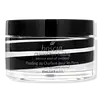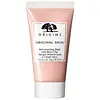What's inside
What's inside
 Key Ingredients
Key Ingredients

 Benefits
Benefits

 Concerns
Concerns

 Ingredients Side-by-side
Ingredients Side-by-side

Water
Skin ConditioningDiglycerin
HumectantGlycerin
HumectantZea Mays Starch
AbsorbentMontmorillonite
AbsorbentKaolin
AbrasiveTalc
AbrasiveEthylhexylglycerin
Skin ConditioningCharcoal Powder
AbrasivePelargonium Graveolens Flower Oil
MaskingSimmondsia Chinensis Seed Extract
AbrasiveCaprylic/Capric Triglyceride
MaskingEpilobium Angustifolium Flower/Leaf/Stem Extract
Skin ConditioningSea Water
HumectantSalicornia Herbacea Extract
Skin ConditioningKappaphycus Alvarezii Extract
Skin ConditioningHydroxyacetophenone
AntioxidantSodium Hyaluronate
HumectantPvp
Emulsion StabilisingAmmonium Acryloyldimethyltaurate/Vp Copolymer
Acrylates Copolymer
Butylene Glycol
HumectantPolysorbate 20
EmulsifyingCI 77891
Cosmetic ColorantWater, Diglycerin, Glycerin, Zea Mays Starch, Montmorillonite, Kaolin, Talc, Ethylhexylglycerin, Charcoal Powder, Pelargonium Graveolens Flower Oil, Simmondsia Chinensis Seed Extract, Caprylic/Capric Triglyceride, Epilobium Angustifolium Flower/Leaf/Stem Extract, Sea Water, Salicornia Herbacea Extract, Kappaphycus Alvarezii Extract, Hydroxyacetophenone, Sodium Hyaluronate, Pvp, Ammonium Acryloyldimethyltaurate/Vp Copolymer, Acrylates Copolymer, Butylene Glycol, Polysorbate 20, CI 77891
Water
Skin ConditioningButylene Glycol
HumectantKaolin
AbrasiveMontmorillonite
AbsorbentPolysorbate 20
EmulsifyingJojoba Esters
EmollientPEG-100 Stearate
Bentonite
AbsorbentGlycerin
HumectantCitrus Grandis Peel Oil
MaskingLavandula Angustifolia Oil
MaskingPelargonium Graveolens Flower Oil
MaskingAmyris Balsamifera Bark Oil
MaskingSalvia Sclarea Oil
MaskingAnthemis Nobilis Flower Oil
MaskingRosa Centifolia Flower Extract
AstringentLimonene
PerfumingLinalool
PerfumingGeraniol
PerfumingEpilobium Angustifolium Flower/Leaf/Stem Extract
Skin ConditioningCastanea Sativa Seed Extract
Skin ConditioningAlbizia Julibrissin Bark Extract
MaskingLecithin
EmollientEthylhexylglycerin
Skin ConditioningCaprylyl Glycol
EmollientPropylene Glycol Laurate
Skin ConditioningPropylene Glycol Stearate
Skin ConditioningPEG-150 Distearate
EmulsifyingHypnea Musciformis Extract
Skin ProtectingGelidiella Acerosa Extract
Skin ProtectingSimethicone
EmollientSodium Hyaluronate
HumectantSorbitan Laurate
EmulsifyingHexylene Glycol
EmulsifyingDehydroacetic Acid
PreservativeXanthan Gum
EmulsifyingTrisodium EDTA
Phenoxyethanol
PreservativeCI 77891
Cosmetic ColorantIron Oxides
Water, Butylene Glycol, Kaolin, Montmorillonite, Polysorbate 20, Jojoba Esters, PEG-100 Stearate, Bentonite, Glycerin, Citrus Grandis Peel Oil, Lavandula Angustifolia Oil, Pelargonium Graveolens Flower Oil, Amyris Balsamifera Bark Oil, Salvia Sclarea Oil, Anthemis Nobilis Flower Oil, Rosa Centifolia Flower Extract, Limonene, Linalool, Geraniol, Epilobium Angustifolium Flower/Leaf/Stem Extract, Castanea Sativa Seed Extract, Albizia Julibrissin Bark Extract, Lecithin, Ethylhexylglycerin, Caprylyl Glycol, Propylene Glycol Laurate, Propylene Glycol Stearate, PEG-150 Distearate, Hypnea Musciformis Extract, Gelidiella Acerosa Extract, Simethicone, Sodium Hyaluronate, Sorbitan Laurate, Hexylene Glycol, Dehydroacetic Acid, Xanthan Gum, Trisodium EDTA, Phenoxyethanol, CI 77891, Iron Oxides
 Reviews
Reviews

Ingredients Explained
These ingredients are found in both products.
Ingredients higher up in an ingredient list are typically present in a larger amount.
Butylene Glycol (or BG) is used within cosmetic products for a few different reasons:
Overall, Butylene Glycol is a safe and well-rounded ingredient that works well with other ingredients.
Though this ingredient works well with most skin types, some people with sensitive skin may experience a reaction such as allergic rashes, closed comedones, or itchiness.
Learn more about Butylene GlycolCi 77891 is a white pigment from Titanium dioxide. It is naturally found in minerals such as rutile and ilmenite.
It's main function is to add a white color to cosmetics. It can also be mixed with other colors to create different shades.
Ci 77891 is commonly found in sunscreens due to its ability to block UV rays.
Learn more about CI 77891We don't have a description for Epilobium Angustifolium Flower/Leaf/Stem Extract yet.
Ethylhexylglycerin (we can't pronounce this either) is commonly used as a preservative and skin softener. It is derived from glyceryl.
You might see Ethylhexylglycerin often paired with other preservatives such as phenoxyethanol. Ethylhexylglycerin has been found to increase the effectiveness of these other preservatives.
Glycerin is already naturally found in your skin. It helps moisturize and protect your skin.
A study from 2016 found glycerin to be more effective as a humectant than AHAs and hyaluronic acid.
As a humectant, it helps the skin stay hydrated by pulling moisture to your skin. The low molecular weight of glycerin allows it to pull moisture into the deeper layers of your skin.
Hydrated skin improves your skin barrier; Your skin barrier helps protect against irritants and bacteria.
Glycerin has also been found to have antimicrobial and antiviral properties. Due to these properties, glycerin is often used in wound and burn treatments.
In cosmetics, glycerin is usually derived from plants such as soybean or palm. However, it can also be sourced from animals, such as tallow or animal fat.
This ingredient is organic, colorless, odorless, and non-toxic.
Glycerin is the name for this ingredient in American English. British English uses Glycerol/Glycerine.
Learn more about GlycerinKaolin is a clay. It is used for oil control and to help minimize pores. Like other clays, kaolin has the ability to absorb excess sebum or oil. This can help clean out pores and mattify the skin.
Some types of kaolin may have exfoliating properties. When water is added to kaolin, it becomes a paste with small abrasive particles.
Most kaolin is a white color, but may be pink/orange/red depending on where it comes from.
The name 'kaolin' comes from a Chinese village named 'Gaoling'. Kaolin clay comes from rocks rich in kaolinite. Kaolinite, the mineral, has a silicate layered structure. Kaolinite is formed from chemical weathering of aluminum siilicate minerals.
Besides skincare, kaolin is commonly used to make glossy paper, in ceramics, toothpaste, and as medicine to soothe stomach issues.
Learn more about KaolinMontmorillonite is a clay (aluminomagnesium silicate) with strong absorption properties. It has a similar pH to skin.
This clay is named after Montmorillon in France.
Learn about other types of clay, such as Kaolin, Bentonite, or Fuller's Earth.
Learn more about MontmorillonitePelargonium Graveolens Flower Oil is the pressed oil of the Rose Geranium plant. It is volatile, meaning it evaporates off the skin.
Fragrant components of Rose Geranium include citronellol and geraniol. These may cause allergies and skin-sensitivity. We recommend speaking with a professional if you have any concerns.
The scent of Rose Geranium closely resembles traditional roses.
Learn more about Pelargonium Graveolens Flower OilPolysorbate 20 is made by combining ethoxylation of sorbitan, ethylene oxide, and lauric acid. It is a mild cleansing agent, surfactant, and emulsifier.
As a surfactant, it helps collect dirt and oils for washing. Emulsifiers prevent oils and water from separating.
Polysorbate 20 also adds scent to a product. Since it is made using sorbitol, it has a sweet scent. Sorbitol can also be found in fruits such as apples and peaches.
The lauric acid used to create Polysorbate 20 is often derived from coconuts.
Polysorbate 20 may not be fungal acne safe.
Learn more about Polysorbate 20Sodium Hyaluronate is hyaluronic acid's salt form. It is commonly derived from the sodium salt of hyaluronic acid.
Like hyaluronic acid, it is great at holding water and acts as a humectant. This makes it a great skin hydrating ingredient.
Sodium Hyaluronate is naturally occurring in our bodies and is mostly found in eye fluid and joints.
These are some other common types of Hyaluronic Acid:
Learn more about Sodium HyaluronateWater. It's the most common cosmetic ingredient of all. You'll usually see it at the top of ingredient lists, meaning that it makes up the largest part of the product.
So why is it so popular? Water most often acts as a solvent - this means that it helps dissolve other ingredients into the formulation.
You'll also recognize water as that liquid we all need to stay alive. If you see this, drink a glass of water. Stay hydrated!
Learn more about Water